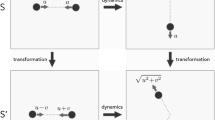Abstract
Herein we present a whole new approach that leads to the end results of the general theory of relativity via just the law of conservation of energy (broadened to embody the mass and energy equivalence of the special theory of relativity) and quantum mechanics. We start with the following postulate.
Postulate: The rest mass of an object bound to a celestial body amounts less than its rest mass measured in empty space, and this, as much as its binding energy vis-á-vis the gravitational field of concern.
The decreased rest mass is further dilated by the Lorentz factor if the object in hand is in motion in the gravitational field of concern. The overall relativistic energy must be constant on a stationary trajectory. This yields the equation of motion driven by the celestial body of concern, via the relationship e α / √ 1 − r 20 / e 20 = constant, along with the definition α = GM / re 20 ; here M is the mass of the celestial body creating the gravitational field of concern; G is the universal gravitational constant, measured in empty space it comes into play in Newton's law of gravitation, which is assumed though to be valid for static masses only; r points to the location picked on the trajectory of the motion, the center of M being the origin of coordinates, as assessed by the distant observer; v 0 is the tangential velocity of the object at r; c 0 is the ceiling of the speed of light in empty space; v 0 and c 0 remain the same for both the local observer and the distant observer, just the same way as that framed by the special theory of relativity.
The differentiation of the above relationship leads to
− GM / r 2 (1 − v 20 / c 20 ) = v 0 dv0dr or, via v 0 = dr / dt, − GM / r 2 (1 − v 20 / c 20 ) ṟ / r = d?? 0 / dt:
?? is the outward looking unit vector along r; the latter differential equation is the classical Newton's Equation of Motion, were v 0, negligible as compared to c 0; this equation is valid for any object, including a light photon.
Taking into account the quantum mechanical stretching of lengths due to the rest mass decrease in the gravitational field, the above equation can be transformed into an equation written in terms of the proper lengths, yielding well the end results of the general theory of relativity, though through a completely different set up.
Similar content being viewed by others
References
1. T. Yarman, “The general equation of motion via the special theory of relativity and quantum mechanics,” Ann. Fond. Louis de Broglie 29 (3) (2004).
2. T. Yarmn, “A novel approach to the end results of the general theory of relativity via just the special theory of relativity and quantum mechanics,” Communication with Professor C. Marchal, Director of Research, ONERA (May 1999); also Invited Talk, whose preprint is under preparation, Lebedev Institute, Moscow, Federation of Russia (July 8, 2005).
3. T. Yarman, Enerji Kaynaklari (Energy Resources: Book), Publications of Anadolu University, Eskisehir, Turkey, 36 (1983).
4. A. Einstein, The Meaning of Relativity (Princeton University Press, 1953).
5. H. Yilmaz, “Einstein, the exponential metric, and a proposed gravitational Michelson-Morley experiment,” Hadronic J. 2, 997 (1979).
6. H. Yilmaz, “Towards a field theory of gravity,” Nuovo Cimento B 107, 941 (1992).
7. H. Yilmaz, “Did the apple fall?,” in Frontiers of Fundamental Physics, M. Barone and F. Selleri, eds. (Plenum, New York, 1994).
Author information
Authors and Affiliations
Corresponding author
Rights and permissions
About this article
Cite this article
Yarman, T. The End Results of General Relativity Theory Via Just Energy Conservation and Quantum Mechanics. Found Phys Lett 19, 675–693 (2006). https://doi.org/10.1007/s10702-006-1057-7
Received:
Revised:
Published:
Issue Date:
DOI: https://doi.org/10.1007/s10702-006-1057-7




